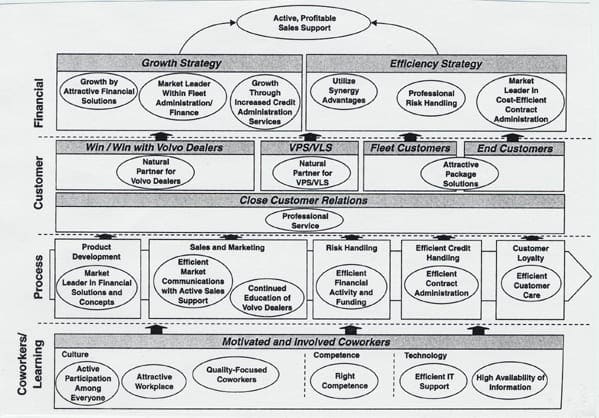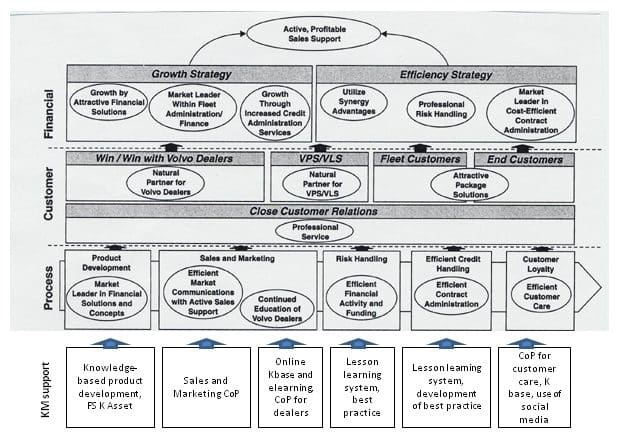KM can be a crucial underpinning for business strategy. Here is a great way of showing how this can be delivered.
I am a firm believer in business led
Knowledge Management Strategy. Sometimes however we seem to lose sight of the KM/strategy link, and KM can then become relegated to a service function – something nice to have, but not strategic.
The KM strategy map is a way of linking KM back to the business strategy, and showing that it has a crucial strategic role to play.
First a bit of background to the strategy map itself.
A strategy map is an established way of mapping out the strategy of a company in a visual way, The approach was invented by Robert S Kaplan, and is well described in
this 2004 HBR article and in his book
Strategy Maps. A strategy map can be linked to Balanced Scorecard, and can be used to explain why a company is choosing the initiatives that it has.
The example above – a strategy map of Volvo Dealership – is taken from one of Kaplans articles, and can also be found here. This map starts at the top with the vision, and works down, via elements of the strategy (in the example shown, growth and efficiency), then looks at the financial, customer, process and learning elements or objectives that support it.
Adding the Knowledge Management layer
As we know, Knowledge Management should be driven by the corporate vision and strategy, and should support the key activities that are needed to deliver that strategy. When Kaplan and Norton developed the ideas around strategy maps, KM was in its infancy and the “learning” elements were pretty generic (and to be honest, judging from examples, the learning elements are still pretty generic).
What KM can do is make these less generic, more specific, and show how the elements of KM can directly support the business strategy.
As an example, I have added a Knowledge Management layer to the HBR “Volvo dealership” map.
Please note this KM layer was not created in consultation with Volvo, nor does it reflect (other than by coincidence) what Volvo are doing in KM. Instead it is the sort of elements, and the sort of KM solutions, that you might be able to add at the bottom of a strategy map, that “flow upwards” to the corporate processes, strategy components, and vision.
Sales and Marketing, for example, can be supported by more than generic “active participation, quality focused co-workers” etc; it could be supported by a Sales and Marketing CoP, actively developing and sharing ideas, solutions, good practices, with a knowledge base of past successful marketing materials and lessons. Similarly continued education of Volvo dealers can be supported by an online knowledge base, eLearning, and a dealers’ community of practice. Risk handling could be supported by an effective lesson learning system.
Each KM intervention supports a process, which supports a customer and financial objective.
There are two advantages of this form of strategic map with a Knowledge Management layer;
- it helps the KM team to focus on those interventions that most directly support business strategy, and
- it makes it clear to the business, and to Top Management, how KM will help in delivering that strategy.
The KM strategy map can be a powerful tool in steering your KM program, and communicating to the leadership of the organisation the value you deliver.



Leave a Reply